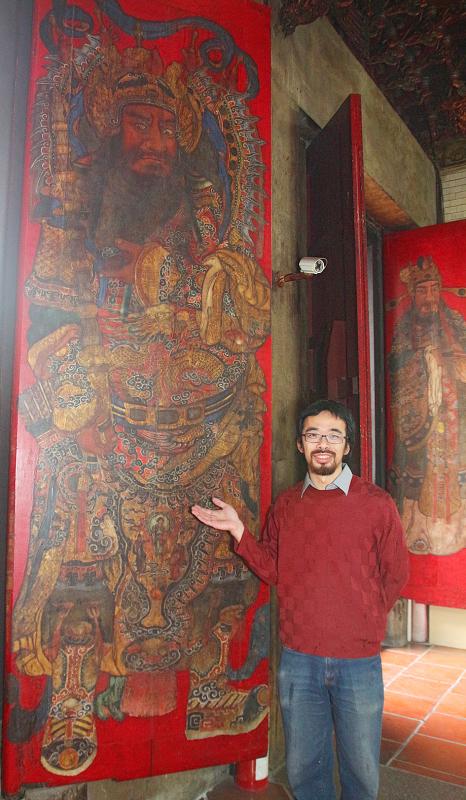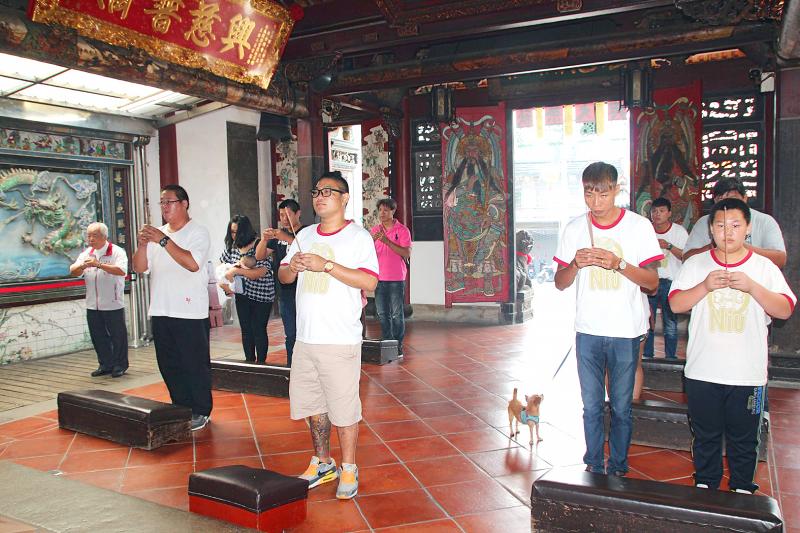The God of Medicine had an uneventful birthday yesterday. Due to the COVID-19 pandemic, even celebrations for Baoshengdadi (保生大帝), also known as the God of Medicine, were significantly downsized across the nation. Tainan’s Singji Temple (興濟宮), for example, held a low-key candle placing ritual Monday night and focused on promoting its artifact exhibition featuring its recently restored door god paintings.
Created by renowned temple painter Chen Shou-i (陳壽彝) in 1977, the doors were painstakingly restored over 18 months by Lee Chih-shang (李志上) and his team at Ming Shiang Art Conservation (名襄文化) and reinstalled last year. Lee, who calls himself a family physician and cosmetic surgeon for antique paintings, says that he’s been working on various artifacts in the temple for the past three years.
Applying Western preservation techniques he learned in Germany to the Taiwanese climate, with the blessing of the sea goddess Matsu, Lee has made it his mission to preserve as much of Taiwan’s cultural heritage as he can. Due to the lack of value placed on local Taiwanese religious culture until recently, and poor conservation technique, much has been lost already. In Germany, Lee practiced on 400-year-old relics, while in Taiwan he has worked on at most five pieces that were created before the Japanese arrived in 1895.

Photo: Ting Wei-chieh, Taipei Times
Before Chen died in 2012, he lamented that there were probably less than 10 of his works still intact despite working on over 200 temples since he was 15 years old.
“Taiwanese did not value their own culture in the past, instead championing tacky or foreign styles. They discarded their local culture and art without knowing how precious they were,” he told the Liberty Times (Taipei Times’ sister newspaper).
BALANCING ACT

Photo: Wang Chu-hsiu, Taipei Times
Chen learned his craft from his father Chen Yu-feng (陳玉峰), who was considered the top artisan painter in Tainan during his day. The elder Chen pioneered a detailed realist style that made use of light, and his son took over the mantle in 1964.
Visitors to Taipei probably will inadvertently see one of Chen Shou-i’s earliest works: the door gods leading to Longshan Temple’s main hall.
This is the second of Chen’s artwork that Lee has restored. In 2017, he worked on the door gods from Tainan’s Zonggan Temple (總趕宮) — Chen’s first commission under his own name after his father died.

Photo courtesy of Singji Temple
Since Zonggan Temple’s doors were already removed and donated to the Tainan Municipal Administration of Cultural Heritage as a relic, all Lee had to do was stabilize the surface to prevent further decay. Since Singji Temple’s doors are still in use, much more work went into it.
Lee uses infrared and UV imaging as well as other scientific techniques to “identify the symptoms” before he gets to work. The first step is to fix the damaged or warped portions and to wash off the layers of yellowed varnish from earlier restoration attempts. Then he decides on the type of paint and methods to use, and reaches into his seasoned repertoire to bring the original artist’s work back to life.
The key is the balance between making the artist’s brush strokes stand out while keeping the dated feel of an antique.
“A cosmetic surgeon doesn’t aim to make an 80-year-old look like an 18-year-old,” Lee says. “We tend to keep some harmless ‘age spots.’ We just want people to be able to see Chen’s colors and brush strokes, and for the door not to seem dirty.”
SAVING HISTORY
Although Lee is confident in the quality of his work, the time and costs are much higher than the average restoration job. His other major ongoing project, Kaohsiung’s Daitian Temple (代天宮), is estimated to cost NT$60 million and will take seven workers four years to complete.
“It’s hard to find a client that completely trusts us,” Lee says. “Usually they just want something fast and cheap.”
Singji Temple, for instance, was so pleased with Lee’s work that they kept adding on new items to restore. The entire process has gone on for more than three years, and currently the restoration work is on hold because of damp plaguing a wall with intricate tiger and dragon reliefs. Lee has convinced the temple to tackle the problem at its roots by treating the wall with a process that will make it water resistant yet breathable — but that will add at least six months to the schedule.
In addition to other human factors, many important relics have been lost to crude restoration jobs, he says, much more than natural weathering. In the worst case for door gods, some artisans sand the entire surface down and simply repaint the images. This is especially damaging since many doors actually have layers of paintings under them. Lee says that often a son or successor of the original artisan will paint over the original image.
For example, Lee used infrared imaging to determine that Chen was the third person to paint over Hsingji Temple’s doors — it was first painted during the Japanese era. A more surprising discovery was found under Chen’s door god at Zonggan Temple — it was a pre-Japanese era image, which is almost unheard of for Tainan’s temples, shedding much light on local artistic styles during the Qing Dynasty.
Lee says he’s like a family doctor to the temple’s he’s finished — some have asked him to return every year for inspection. He revisits his old work frequently to evaluate how his European techniques are holding up to Taiwan’s climate, making adjustments and repairs accordingly.
“I just really love Taiwan and I want to protect its cultural heritage,” he says.
He adds that before he began his career, he prayed to Matsu at Lugang’s Tianhou Temple (天后宮).
“She said that I will sail through tempestuous seas in my career, but she will keep a light for me so I can reach the calm sky after the storm,” he says.

The Lee (李) family migrated to Taiwan in trickles many decades ago. Born in Myanmar, they are ethnically Chinese and their first language is Yunnanese, from China’s Yunnan Province. Today, they run a cozy little restaurant in Taipei’s student stomping ground, near National Taiwan University (NTU), serving up a daily pre-selected menu that pays homage to their blended Yunnan-Burmese heritage, where lemongrass and curry leaves sit beside century egg and pickled woodear mushrooms. Wu Yun (巫雲) is more akin to a family home that has set up tables and chairs and welcomed strangers to cozy up and share a meal

Dec. 8 to Dec. 14 Chang-Lee Te-ho (張李德和) had her father’s words etched into stone as her personal motto: “Even as a woman, you should master at least one art.” She went on to excel in seven — classical poetry, lyrical poetry, calligraphy, painting, music, chess and embroidery — and was also a respected educator, charity organizer and provincial assemblywoman. Among her many monikers was “Poetry Mother” (詩媽). While her father Lee Chao-yuan’s (李昭元) phrasing reflected the social norms of the 1890s, it was relatively progressive for the time. He personally taught Chang-Lee the Chinese classics until she entered public

Last week writer Wei Lingling (魏玲靈) unloaded a remarkably conventional pro-China column in the Wall Street Journal (“From Bush’s Rebuke to Trump’s Whisper: Navigating a Geopolitical Flashpoint,” Dec 2, 2025). Wei alleged that in a phone call, US President Donald Trump advised Japanese Prime Minister Sanae Takaichi not to provoke the People’s Republic of China (PRC) over Taiwan. Wei’s claim was categorically denied by Japanese government sources. Trump’s call to Takaichi, Wei said, was just like the moment in 2003 when former US president George Bush stood next to former Chinese premier Wen Jia-bao (溫家寶) and criticized former president Chen

President William Lai (賴清德) has proposed a NT$1.25 trillion (US$40 billion) special eight-year budget that intends to bolster Taiwan’s national defense, with a “T-Dome” plan to create “an unassailable Taiwan, safeguarded by innovation and technology” as its centerpiece. This is an interesting test for the Chinese Nationalist Party (KMT), and how they handle it will likely provide some answers as to where the party currently stands. Naturally, the Lai administration and his Democratic Progressive Party (DPP) are for it, as are the Americans. The Chinese Communist Party (CCP) is not. The interests and agendas of those three are clear, but